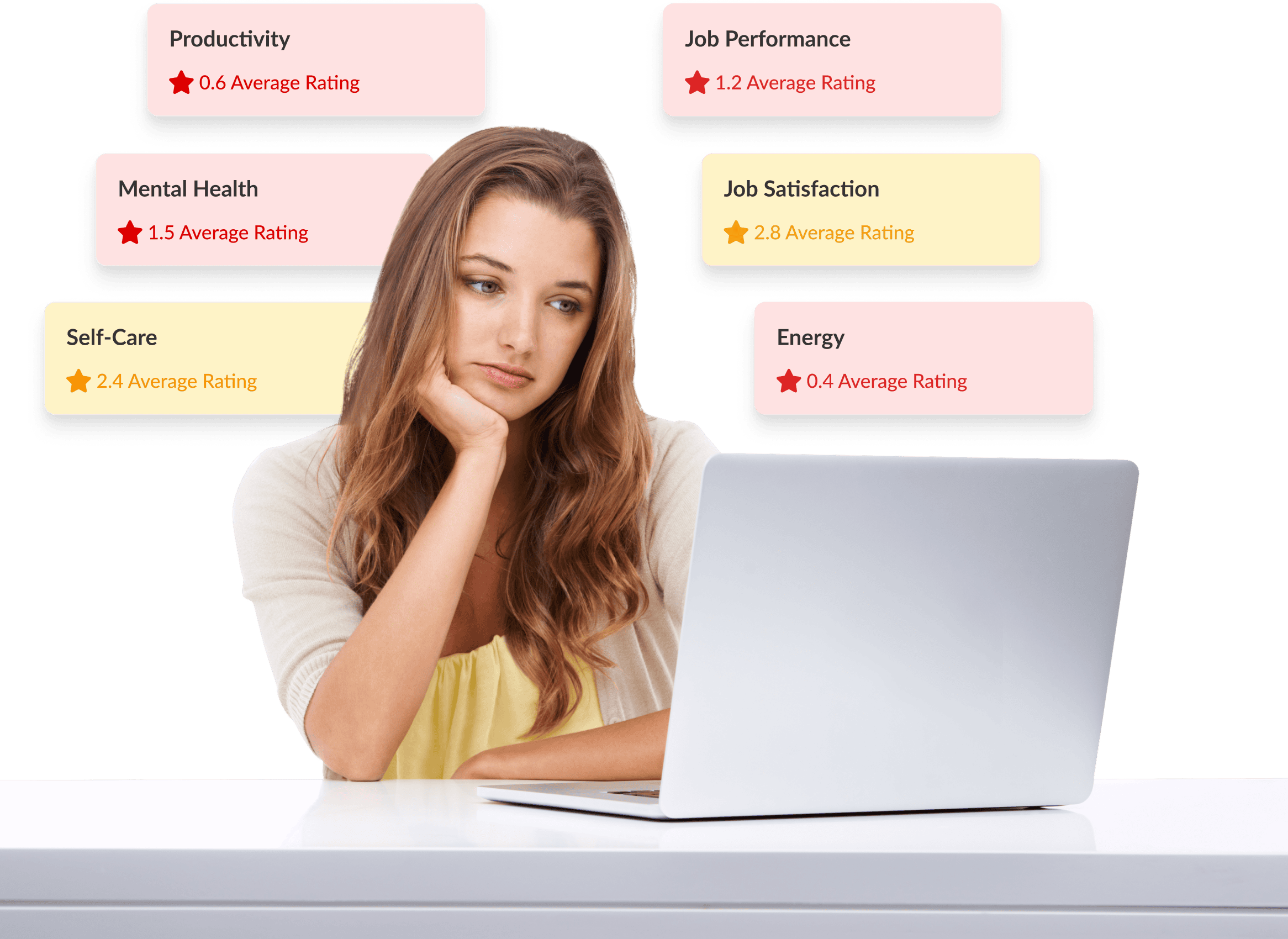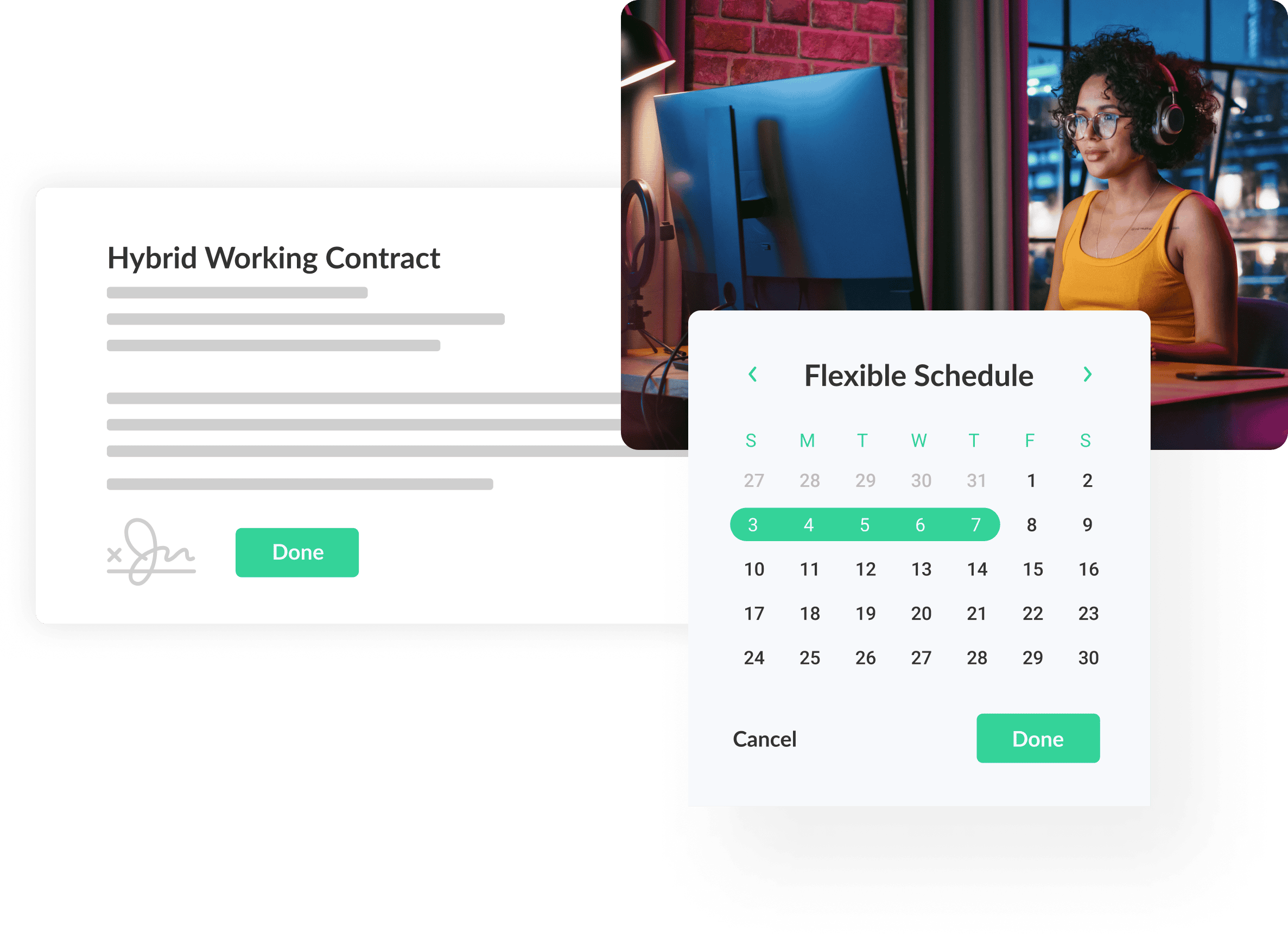
What Do Hiring Managers Do?
If you’re looking for a job, you should know who the hiring manager is and what they’ll be doing.

If you’ve been ignoring employee burnout, here’s your wake-up call – a 2023 survey by APA showed 77% of workers reported experiencing work-related stress, and 57% of those experienced symptoms of burnout.
Members of the modern workforce have been faced with hard-to-control challenges such as an unhealthy work/life balance, an unmanageable workload, and limited opportunities to relieve stress. The option to work remotely for a lot of office workers has created additional stressors, such as the pressure to work while ill and an expectation for an “always-available” response time.
Many organizations are taking steps to acknowledge and reduce burnout. Initiatives are being adopted to focus on employees’ mental health and general well-being. But, as the statistics show, there’s still a long way to go.
Employee burnout (also known as job burnout or work burnout) is a type of work-related stress that’s recognized by the World Health Organization (WHO) as an occupational phenomenon. The WHO characterizes job burnout by the persistence of three factors:
Feelings of energy depletion or exhaustion
Increased mental distance or feelings of negativity related to a job
Reduced professional efficacy
Experiencing these symptoms periodically is fairly normal. However, burnout is defined by the persistence of all three of these factors. So, if you notice employees are consistently exhibiting these characteristics, or you notice them in yourself – it may be burnout.

Here are some of the top work-related situations that can contribute to feelings of job burnout.
It’s not uncommon for employees to be uncertain about the expectations of their role. They may have never been properly onboarded, or perhaps their organization isn’t even sure what they should be doing – more prevalent in specialist, one-department roles.
When an employee isn’t given enough structure, direction, or guidance in the workplace, it can feel impossible to keep up with demands or meet expectations.

When work piles up, it’s necessary to pick up the pace and possibly work some overtime. The workdays can quickly become a blur between meetings, calls, and planning. While every organization has busy periods, these are usually evened out by quieter times. When an employee is constantly working at 110% to keep up with demand, it can feel as though they’ve lost control of their workload.

We all know that “communication is key” but what happens when an employee believes there’s a lack of communication at work? Employees are likely to develop feelings of being lonely, confused about their duties, and anxious to work – all of which can lead to burnout.
In a recent Grammarly report, 50% of workers said poor communication increased their stress levels. But that’s not all: 22% said poor communication makes them consider finding a new job.

Nowadays, it’s extremely easy for employees to stay connected wherever they are. Work tools such as instant messaging software or email can be utilized on personal phones, and video conferencing platforms make anywhere a meeting room. While these tools can be tremendously helpful, they can also blur the line between work and personal time.

Do your employees work through lunch or after work hours? Chances are, they do.
ADP discovered that, on average, employees complete over six hours of unpaid overtime each week to get their work done.
Poor leadership can cause a breakdown in communication, a lack of teamwork, mistrust, and unclear expectations – many factors that contribute to burnout. One problem with today’s workforce is a lack of management training. In a 2023 survey by Oji Life Lab, those who have worked under a first-time manager report negative impacts such as stress or anxiety about going to work (41%) and a loss of confidence (31%) in the organization due to their manager.

When employees feel as though their work goes unnoticed (or worse, they only receive critical feedback) they’ll likely feel inadequate, lose a sense of belonging and motivation to try – factors that can quickly escalate to burnout.
Furthermore, research by Gallup and Workhuman shows employees who lack a sense of belonging are up to 12 times as likely to be disengaged and five times as likely to be searching for another job.

Is AI helping or hindering work burnout?
In the last year, AI tools have transformed what’s possible with a click of a button. In seconds, employees can use AI to generate things like content, code, and imagery – saving them significant time and energy. But, are these advancements helping employees do their jobs better, or is the ability of AI adding stress? APA reported two out of five employees are concerned AI’s abilities could make some or all of their job duties obsolete. Out of those worried, 64% also reported typically feeling tense or stressed during the workday.
Some symptoms of employee burnout may be easily recognizable, but it can be common for employees to hide the signs, and much harder to detect burnout in remote employees. Therefore it’s important to be vigilant. Below are some of the main symptoms of job burnout:
Exhaustion is the most common symptom of work burnout. Whether it’s emotional, mental, or physical exhaustion, being sapped of all energy can be detrimental to an employee’s well-being and performance on the job. Employees suffering from exhaustion will often have difficulty finding the motivation and focus needed to complete work to the best of their ability.
It is very common for employees suffering from burnout to take more sick days. Additionally, employees may show up late or appear to be offline when they should be online. Suffering employees often seek to avoid projects, coworkers, or leaders that may be a source of their stress. When absences without compelling excuses become the norm, it may be a sign of burnout.
Struggling employees may become increasingly reclusive. Due to the exhausting nature of burnout, it’s common for formerly social individuals to become quiet and distant, attempting to withdraw from their surroundings. Isolated employees may participate less in meetings, miss or avoid important calls, and can even be irritable or aggressive to avoid communicating with others.
Often burnout causes employees to feel overwhelmed, exhausted, and stressed out, all of which can significantly reduce an employee's productivity. Employees may be unable to meet deadlines and quotas, or complete tasks at the rate they were once able to. Burnout can also cause the quality of work to suffer, due to trouble focusing or a lack of pride.
Physical symptoms can often emerge in affected individuals. Burnt-out employees can suffer from headaches, panic attacks, nausea, hypertension, and an abnormal loss of appetite. Burnout can also worsen pre-existing health conditions, including types of chronic pain and heart disease.

Burnout symptoms are becoming more common
In the last 5 years “burnout symptoms” has become an increasingly popular search term on Google. It’s likely a mix of employees researching the symptoms of burnout and managers trying to learn what burnout looks like. What’s certain, though, is the search results show how burnout is more prevalent in today’s culture.
Based on the signs of burnout, it should be clear that burnout isn’t simply an issue for the individual. Here are some of the ways employee burnout can have harmful implications for organizations too:
Burnout can be costly to businesses if not dealt with accordingly. It’s estimated that burnout costs the US $125 to $190 billion every year in healthcare (Harvard Business School). Employers see these costs materialize through higher turnover, absenteeism, presenteeism, reduced productivity, and an increase in workplace incidents.
How much money does it take to replace an employee?
When an employee leaves, they take with them their knowledge of your business, any additional training that’s been paid for, and their unique soft skills that went beyond the job requirements. The true cost of replacing an employee can vary dramatically, Gallup estimates it can cost anywhere between one-half to two times the employee's annual salary.
An employee suffering from work-related burnout will likely be far more disengaged and mentally detached from the ‘big picture.’ In recent times, this has been coined as “quiet quitting’. Quiet quitting isn’t actually quitting a job, it’s when someone deliberately does the bare minimum to remain employed in an attempt to reduce stress and create boundaries. Gallup suggests that low-engaged employees cost the global economy $8.8 trillion a year.
Employees who are happy in a job role are far more likely to work toward an organization’s goals because they value its success. However, stressed-out employees or past employees with a grudge won’t hold back on sites like Glassdoor and LinkedIn. This can create a negative reputation and discourage others from applying.

It’s important to be proactive, not only to reduce visible cases of burnout in your organization but also to help those you’re unaware are burnt out. Here we’ve outlined some of the top ways you can prevent your employees from burning out:
One of the most powerful and effective methods to fight work burnout is positive reinforcement. Managers and executives can sometimes fall into the trap of simply pointing out an employee’s faults – what they could improve upon – rather than acknowledging what they’re doing well. Recognizing hard work with positive reinforcement may seem like you’re pointing out the obvious, but it can significantly help employees to know what they are specifically doing well at. Plus, in turn, they’ll know how to keep on the right track.
To be an effective leader, having compassion is extremely important. Compassion recognizes that every employee is a component in the success of an organization – there’s an opportunity to learn from others, regardless of their role or authority. It’s also compassionate to influence others without being authoritative, finding ways to encourage and guide employees positively.
Burnout is often something employees have trouble speaking about. When leadership takes a compassionate approach to their employees, it makes it much easier for employees to be honest and tackle their issues without the worry of consequences or judgment.
When recognition is an important part of an organization’s culture, employees are 3.7 times as likely to be engaged and about half as likely to experience frequent burnout (Gallup and Workhuman).
It’s normal for work to become stressful for periods of time, but the risk of burnout heightens when there is no outlet for an employee to cope with stress.
Support systems can provide your employees with a method to deal with difficult times at work. Encourage a supportive team by being open and honest about your own work hurdles. Alternatively, simply acknowledge when work is busy or a tough project is being undertaken, and ask employees how they feel. Providing the ability to discuss frustrations, or work through occupational challenges freely is an invaluable tool for dealing with negative feelings that lead to work burnout.
Taking short breaks periodically for stretching, guided breathing, and even meditation or yoga is really beneficial for mental health – and in turn, can reduce burnout. Any of these breaks from the regular workday can have a great impact on motivation, focus, and mood. Employers should encourage employees to set time aside to participate in these brief intermissions in the workday, or better still, offer your employees free resources that aid the effectiveness of these breaks.
“A great practice for managers is to conduct regular 1:1 discussions with their team members. This way, they will be able to project any potential employee issues, and proactively fix them.”
Elena Klitko,
Career Coach at EcoWorkLifeProviding flexibility for your team can help to improve satisfaction and productivity. Rather than commuting to the office every day, employees and employers have recognized that a hybrid solution, such as working from home for select days of the week, can be just as effective as only working from the office. Having the option to work from multiple locations can reduce stress, boost morale, and promote a greater work-life balance.
Flexibility isn't just limited to the location of your employees. Being able to create a flexible schedule that goes beyond the regular 9-5 workday can aid in minimizing the stress of employees. Increased freedom in scheduling can empower employees to choose what time works best for them, which is often their most productive hours. A win-win for employers looking to minimize burnout and increase productivity.
Employees without access to flexible work conditions are nearly 2x more likely to have poor mental health (FlexJobs).

Unfortunately, many workplaces exhibit signs of bullying and discrimination.
Toxic work environments can be a large contributor to exhaustion and negatively affect an employee’s well-being – both in the workplace and outside. Creating and enforcing a safe environment that’s respectful and fair is not only key in combating burnout – it’s the law.
Employees suffering from burnout are likely to be in a state of mental distress. Depression, anxiety, and panic attacks are very common, and not every workplace has resources to help with mental health concerns. Introduce wellness initiatives that focus on emotional and occupational wellness, such as discounts on therapy, paid mental health days, and mindfulness training. These initiatives can help employees deal with issues such as work difficulties or improving their overall mental health. It’s easy for employees to disregard self-care when they’re feeling burnt out or stressed, but it can become a priority with an employer who encourages it.
89% of employees at companies that support their well-being are more likely to recommend their workplace as a good place to work (American Psychological Association).
The fight against employee burnout is never-ending, but leaders must be proactive to reduce the risk and impact of burnout as much as possible. Make your team feel valued and recognized, provide them with multiple systems of support, eliminate discrimination, and provide mental health-centered benefits.
When working with employees who are suffering or at risk of burnout, it’s key to focus on positivity. Encourage employees to speak out, make sure their work is validated and they are aware of what they are doing right. Compassionate leadership will also make your team feel equal and respected, while wellness initiatives can encourage employees to better themselves physically, emotionally, and mentally. Finally, providing flexible working conditions can help to empower employees to create a work environment that’s best for them.
Genuine care for your employees matters most, and an individual who feels valued is far less likely to suffer from the perils of work burnout.
“The best way to solve employee burnout problems is to prevent them from happening in the first place. That means finding the right employee and onboarding them effectively. On day one, every new hire should receive a written role description and a 90-day onboarding plan that includes 30, 60, and 90-day goals, key metrics, and an assigned mentor within the company. That way, they're an important member of the team starting from the first day on the job."
Will Pemble,
Goal Boss, Coaster Dad
Employee burnout is a type of work-related stress characterized by exhaustion, negative attitudes towards one's job, and feeling unsuccessful in their work.
The WHO (World Health Organization) characterizes job burnout by the persistence of three factors:
Quitting your job shouldn’t be a decision you make lightly, especially if you’re acting on rash emotions. If you’re feeling burnt out, try to get to the bottom of why you’re feeling this way – our chapter “What Causes Work Burnout?” may help give you clarity. Speak to your manager, share how you’re feeling and why. Your manager should work with you to alleviate the feelings of burnout. If you still feel burnt out, reach out to HR for professional assistance. Try your best to overcome feelings of burnout before you decide to look elsewhere.
Employees and employers alike can mitigate the symptoms of burnout by keeping an open line of communication. Ask and listen to how employees are feeling, particularly when employees seem overwhelmed or they’re showing signs of burnout. It can be common for employees to hide their symptoms of burnout, so it’s important to be vigilant and proactive, rather than reactive. Aside from proactive communication, our chapter “How Can Employers Prevent Burnout?” lists many ways leaders can alleviate the symptoms of burnout.
Modernize your hiring process with expert insights and advice.